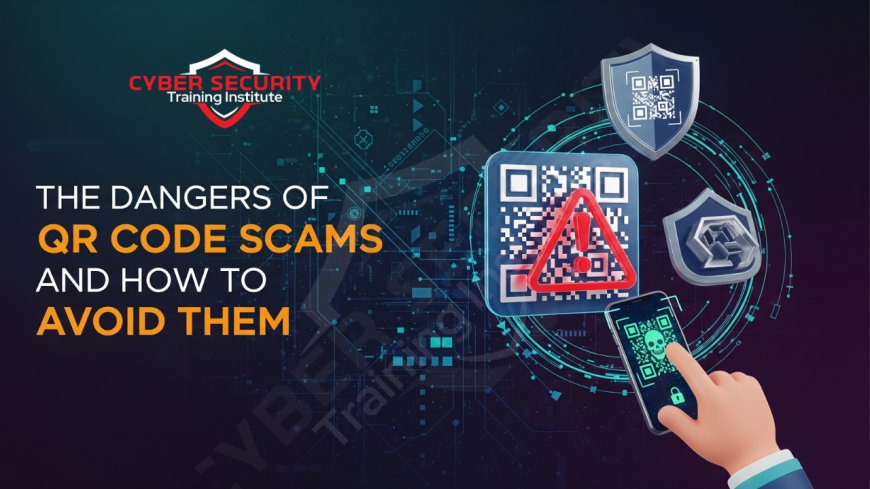The Dangers of QR Code Scams and How to Avoid Them
Imagine you’re at a restaurant, ready to pay your bill, and the server hands you a QR code to scan for a quick, contactless payment. Or maybe you’re walking through a parking lot and spot a QR code on a meter promising a convenient way to pay. These little black-and-white squares have become a staple of modern convenience, but they come with a hidden risk. QR code scams are on the rise, and scammers are getting craftier every day. In this blog post, we’ll dive into what QR code scams are, how they work, and—most importantly—how you can protect yourself from falling victim. Whether you’re a tech newbie or a seasoned smartphone user, this guide will equip you with the knowledge to stay safe.

Table of Contents
- What Are QR Code Scams?
- How QR Code Scams Work
- Common Types of QR Code Scams
- Real-World Examples of QR Code Scams
- How to Spot a Suspicious QR Code
- Tips to Avoid QR Code Scams
- What to Do If You’ve Scanned a Malicious QR Code
- Conclusion
- Frequently Asked Questions (FAQs)
What Are QR Code Scams?
QR codes, or Quick Response codes, are those square-shaped barcodes you scan with your smartphone to access a website, make a payment, or view a menu. They’re incredibly convenient, but that convenience makes them a prime target for scammers. A QR code scam involves a malicious QR code designed to trick you into sharing personal information, downloading malware, or sending money to a fraudster. Unlike traditional scams that rely on emails or phone calls, QR code scams exploit our trust in these seemingly harmless codes found in everyday places like restaurants, parking lots, or even emails.
The danger lies in how easy it is for scammers to create and distribute fake QR codes. A single scan can lead you to a fraudulent website that looks legitimate or install harmful software on your device. With QR codes now appearing everywhere, from product packaging to public posters, it’s more important than ever to understand the risks.
How QR Code Scams Work
QR code scams work by exploiting the trust we place in technology. When you scan a QR code, your phone typically opens a website, prompts a payment, or downloads a file. Scammers manipulate this process to their advantage. Here’s how it usually goes:
- Creation: A scammer creates a QR code that links to a malicious website or app.
- Distribution: They place the QR code in public places, send it via email, or even stick it over a legitimate QR code (a tactic called “QR code overlay”).
- Deception: When you scan the code, you’re directed to a fake website that mimics a trusted brand, like a bank or retailer, or you’re prompted to download an app that contains malware.
- Exploitation: You enter personal details, such as login credentials or credit card information, which the scammer steals. Alternatively, malware on your device can track your activity or lock your files for ransom.
The simplicity of QR codes makes them an attractive tool for scammers, as they require minimal effort to create and can be deployed almost anywhere.
Common Types of QR Code Scams
QR code scams come in various forms, each designed to exploit a different situation. Below is a table summarizing the most common types of QR code scams, their methods, and their goals:
| Scam Type | Method | Goal |
|---|---|---|
| Phishing | QR code leads to a fake website that mimics a trusted service, like a bank or social media platform. | Steal login credentials or personal information. |
| Payment Fraud | QR code prompts a payment to a scammer’s account, often disguised as a legitimate vendor. | Steal money directly from your bank account or payment app. |
| Malware Download | QR code triggers the download of a malicious app or file. | Infect your device with spyware, ransomware, or other malware. |
| Fake Promotions | QR code promises discounts or rewards but leads to a scam site. | Collect personal data or trick you into subscriptions. |
Real-World Examples of QR Code Scams
To illustrate the dangers, let’s look at some real-world scenarios where QR code scams have caused harm:
- Parking Lot Scams: In 2023, several cities reported fake QR codes placed on parking meters. Drivers scanned the codes expecting to pay for parking but ended up on fraudulent websites that stole their credit card details.
- Restaurant Menu Scams: Some restaurants have had their legitimate QR code menus replaced with fake ones. Customers scanning these codes were directed to phishing sites that requested login credentials or payment information.
- Email Scams: Scammers send emails with QR codes claiming to be from trusted companies like Amazon or PayPal, urging users to scan for package tracking or account verification. These codes often lead to phishing pages.
- Charity Scams: During natural disasters, scammers have distributed QR codes claiming to collect donations for relief efforts, only to pocket the funds.
These examples show how QR code scams can blend seamlessly into everyday situations, making vigilance crucial.
How to Spot a Suspicious QR Code
Not every QR code is dangerous, but knowing how to spot a suspicious one can save you from trouble. Here are some red flags to watch for:
- Unusual Locations: Be cautious of QR codes in unexpected places, like random posters or stickers on public property.
- Overlays: Check if the QR code looks like it’s been stuck over another one. Scammers often place their codes over legitimate ones.
- Urgency or Offers: QR codes promising urgent rewards, like “Scan now to claim your prize!” are often scams.
- Strange URLs: Before entering any information, check the URL the QR code takes you to. Look for misspellings or unfamiliar domains (e.g., “paypa1.com” instead of “paypal.com”).
- Unsolicited Emails: QR codes sent via email or text from unknown sources should be treated with suspicion.
By staying alert to these signs, you can avoid scanning a malicious QR code in the first place.
Tips to Avoid QR Code Scams
Protecting yourself from QR code scams doesn’t require advanced tech skills—just a bit of caution and some smart habits. Here’s how to stay safe:
- Preview the URL: Many QR code scanners let you see the URL before visiting the site. If it looks suspicious, don’t proceed.
- Use a Trusted Scanner: Use a QR code scanner app with built-in security features that warn you about malicious links.
- Verify the Source: If a QR code comes from an email or message, confirm the sender’s identity before scanning. Contact the company directly if unsure.
- Avoid Public Wi-Fi: Scanning QR codes on public Wi-Fi can increase the risk of data theft. Use a secure connection or mobile data.
- Keep Software Updated: Ensure your phone’s operating system and apps are up to date to protect against malware.
- Use Two-Factor Authentication: Enable two-factor authentication (2FA) on your accounts to add an extra layer of security in case your credentials are stolen.
- Be Skeptical of Deals: If a QR code promises an unbelievable deal, it’s probably too good to be true.
By following these tips, you can enjoy the convenience of QR codes without falling into a scammer’s trap.
What to Do If You’ve Scanned a Malicious QR Code
If you suspect you’ve scanned a malicious QR code, act quickly to minimize damage:
- Disconnect from the Internet: Turn off Wi-Fi and mobile data to prevent further communication with the malicious site or app.
- Run a Security Scan: Use antivirus software to scan your device for malware.
- Change Passwords: If you entered login credentials, change your passwords immediately on a secure device.
- Monitor Accounts: Check your bank accounts, credit cards, and other sensitive accounts for unauthorized activity.
- Contact Your Bank: If you made a payment, inform your bank or payment provider to freeze the transaction if possible.
- Report the Scam: Report the incident to your local authorities or a cybercrime reporting platform, like the FBI’s Internet Crime Complaint Center (IC3).
Taking swift action can limit the damage and help prevent others from falling victim.
Conclusion
QR codes have revolutionized how we access information and make transactions, but their widespread use has opened the door to new types of scams. From phishing websites to malware downloads, QR code scams are a growing threat that can catch even the most cautious users off guard. By understanding how these scams work, recognizing suspicious QR codes, and adopting simple safety habits, you can protect yourself and your personal information. Stay vigilant, verify sources, and always double-check URLs before sharing sensitive details. With a little caution, you can enjoy the benefits of QR codes without falling prey to scammers.
Frequently Asked Questions (FAQs)
What is a QR code scam?
A QR code scam involves a malicious QR code that tricks users into visiting fake websites, downloading malware, or sharing personal information.
How do scammers distribute QR codes?
Scammers place QR codes in public places, send them via email or text, or overlay them on legitimate codes, like those on parking meters or menus.
Can scanning a QR code hack my phone?
Scanning a QR code alone can’t hack your phone, but it can lead you to malicious websites or apps that steal data or install malware.
What should I do if I scan a suspicious QR code?
Disconnect from the internet, run a security scan, change passwords, monitor accounts, and report the scam to authorities.
Are all QR codes dangerous?
No, most QR codes are safe, but you should be cautious of codes from unknown sources or in unusual locations.
How can I check if a QR code is safe?
Use a QR code scanner that previews the URL, and check for misspellings or unfamiliar domains before visiting the site.
Can QR codes steal my bank information?
Yes, if a QR code leads to a fake payment page where you enter your bank details, scammers can steal that information.
Why are QR code scams so common now?
QR codes are widely used and trusted, making them an easy target for scammers to exploit with minimal effort.
Can I trust QR codes in restaurants?
Verify the QR code’s source with restaurant staff, as scammers may replace legitimate codes with fake ones.
What is a QR code overlay scam?
It’s when scammers place a fake QR code sticker over a legitimate one, directing users to a malicious site.
Can QR codes install viruses?
Yes, if a QR code prompts you to download a malicious app or file, it can install malware on your device.
How do I know if a QR code is legitimate?
Check the source, preview the URL, and avoid codes that promise urgent rewards or come from unsolicited messages.
Can QR codes in emails be trusted?
Be cautious of QR codes in unsolicited emails. Verify the sender’s identity before scanning.
What’s the safest way to scan a QR code?
Use a trusted QR code scanner app with security features and avoid scanning on public Wi-Fi.
Can QR codes expire?
QR codes don’t expire, but the linked content may become inactive or be replaced with malicious content by scammers.
Should I use my phone’s camera to scan QR codes?
Your phone’s camera is safe for scanning, but use a QR code app with URL preview for added security.
Can QR codes track my location?
If a QR code links to a site that requests location access, it could track you, so always deny unnecessary permissions.
How do I report a QR code scam?
Report it to local authorities or cybercrime platforms like the FBI’s IC3 website.
Are QR code scams illegal?
Yes, creating or distributing malicious QR codes to steal data or money is illegal and considered cybercrime.
How can I educate others about QR code scams?
Share this blog, warn friends about suspicious QR codes, and encourage them to verify sources before scanning.
What's Your Reaction?
 Like
0
Like
0
 Dislike
0
Dislike
0
 Love
0
Love
0
 Funny
0
Funny
0
 Angry
0
Angry
0
 Sad
0
Sad
0
 Wow
0
Wow
0










![How to Install RHEL 10 on VMware/VirtualBox [Tutorial]](https://www.cybersecurityinstitute.in/blog/uploads/images/202509/image_430x256_68b56dc967a4a.jpg)






